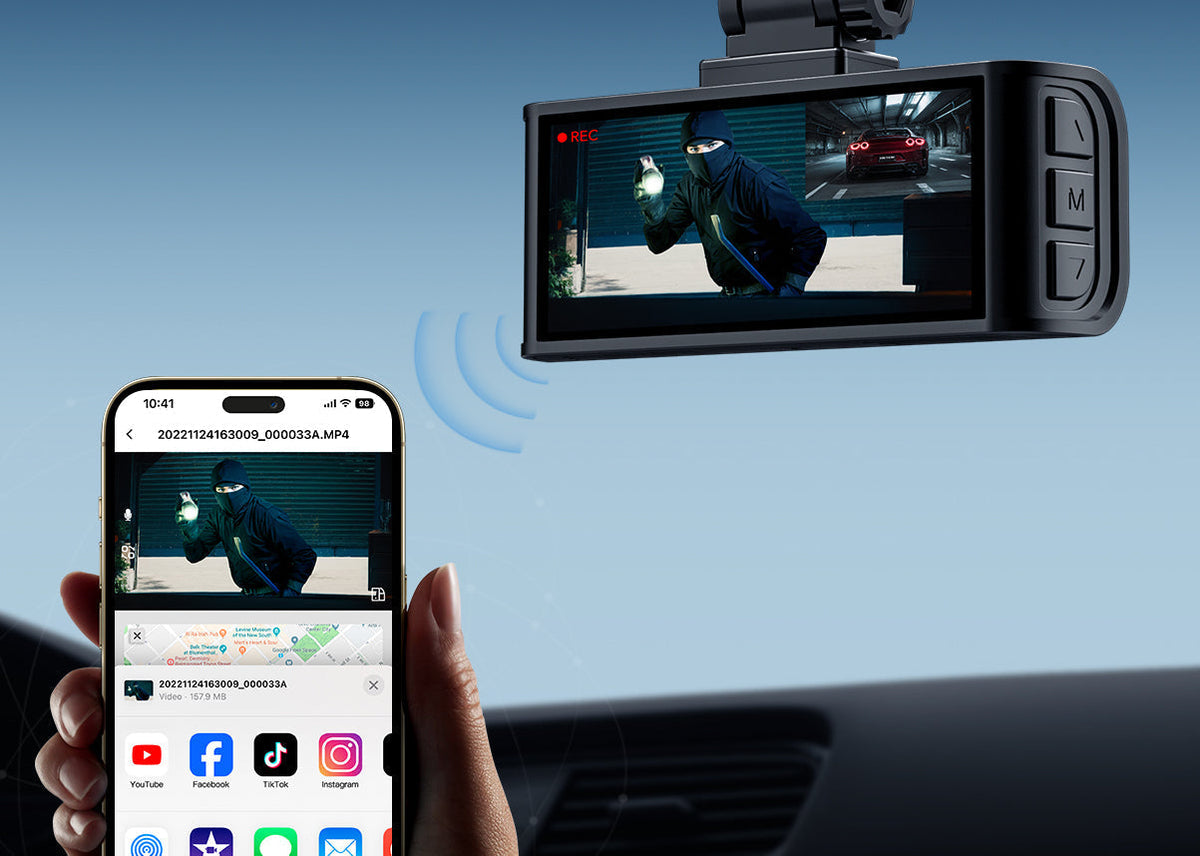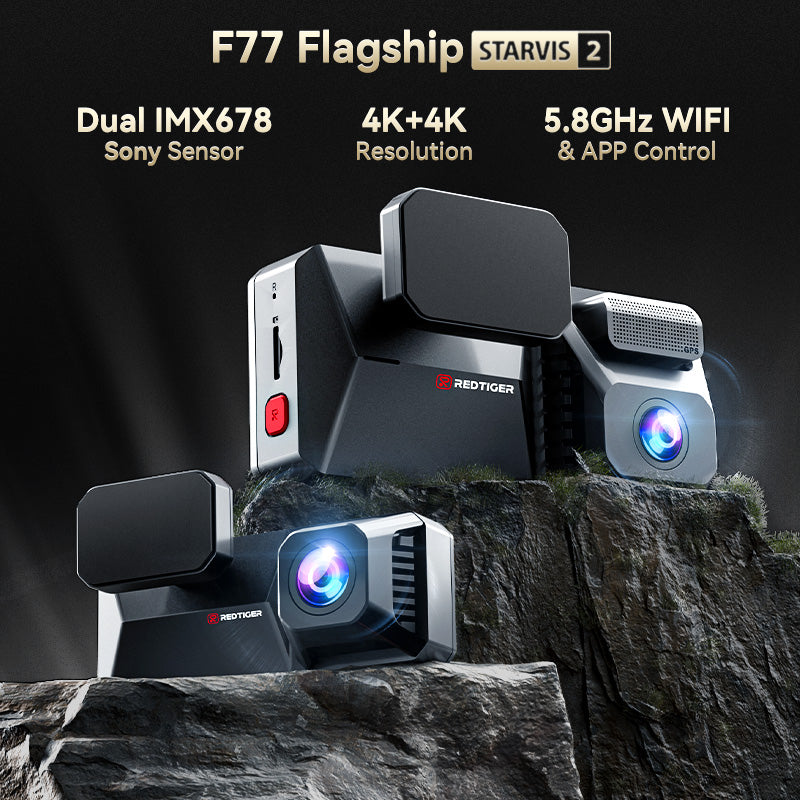

A wireless dash cam for your car makes driving safer and brings you peace of mind. With wireless features, you can store and view your videos easily, without having to deal with tangled wires or swap memory cards. Whether you care about security, want to record your travels or need a backup for insurance, a wireless dash cam is a helpful tool.
This guide will help you understand how wireless dash cams work, why you might want one and how you can set one up for the best experience.
Table of contents
What Makes a Dash Cam “Wireless”
You may think "wireless" means no wires at all, but that's not the case for dash cams. A wireless dash cam usually still needs a power cable because it does not work only on batteries. Instead, “wireless” is about how the camera sends or saves video. These dash cams use Wi-Fi, Bluetooth or mobile data (like LTE or the cloud) to send your videos to your phone, tablet or to the cloud for easy storage.
So, while you still plug the dash cam in for power, you do not have to physically remove an SD card to get your video. You just use your phone, an app or a computer to access it. This is much easier and safer when you need a video quickly.
Benefits of a Wireless Dash Cam for Car
A wireless dash cam does more than record what happens on the road.
Seamless Cloud Backup
With a wireless dash cam, all your videos are uploaded directly to the cloud as soon as they are recorded. You never have to worry about losing videos if your camera is damaged or stolen. Even when you're away, your footage stays safe online and you can access it from anywhere.
Instant Access with an App
You can view your live or saved videos instantly by using a simple app on your phone. You do not need to take out a memory card. If an incident happens, you can check your footage in seconds and show it right away to someone if needed.
Large Storage Without Worry
Traditional dash cams rely on small SD cards that can get full fast. Wireless dash cams store videos in the cloud, giving you lots more storage space. You can record long trips without thinking about running out of room or deleting old files.
Easy Retrieval of Videos
No more fumbling with small cards or computer cables. Just open the app and download any video you need. This saves time and makes it much easier if you have to share a video with your insurance company or with the police.
Secure and Private Data
Storing footage online means your data can be protected by strong passwords and encryption. Only you can see your recordings unless you choose to share them. This keeps your privacy safe and stops others from accessing your videos.
More Peace of Mind
When you have remote access and storage, you can relax knowing your footages are safe. Even if something happens to your car, your records are always available.
Top Use Cases for Wireless Dash Cams
Rideshare Driving
If you drive for Uber, Lyft or other rideshare services, a wireless dash cam helps you keep passengers and yourself safe. In case of a complaint or incident, you can quickly show what happened using saved videos on your phone.
Fleet Management for Businesses
Businesses with several vehicles use wireless dash cams to watch over drivers and cars. Fleet managers can look at video recordings in real time or after a trip, check for safe driving and keep everyone accountable. This can help lower costs and improve service.
Checking on Teen Drivers
Parents often worry when their teenagers start driving. By installing a wireless dash cam for car, you can see how your teen is driving, even if you're not in the car. The video is always available if questions arise about safety or accidents.
Recording Road Trips
If you love adventures, a wireless dash cam lets you save every part of your journey. The videos are clear and always stored online, so you do not miss memorable moments or amazing views. You can share your trips easily with family and friends.
Ensuring Parking Safety
When you leave your car parked, anything could happen. Wireless dash cams with parking mode record if someone bumps, scratches, or tries to break in. You can get a warning on your phone and see what happened, even if you’re far away.
How Wireless Dash Cameras for Car Are Powered
Even though wireless dash cams send data without cables, they do need power to work.
Using the 12V Car Outlet
The easiest way is to use your car’s 12V outlet (also called the cigarette lighter socket). Just plug in the dash cam’s power adapter and you’re ready to go. This is quick, simple and does not need wiring skills.
Hardwiring Kits
You can use a hardwiring kit to connect the dash cam directly to your car’s electrical system. This keeps your dash cam running even when your car is parked. It also lets you hide wires and creates a tidy look in your car.
Battery Packs
Some dash cams connect to a rechargeable battery pack. This is portable and does not use your car’s power, but the battery will need recharging. It’s good if you can’t access the car’s power outlets.
OBD-II Connection
Certain dash cams allow you to connect through the OBD-II port (the same port mechanics use). This can be a simple method as it’s often easy to reach and does not need professional help.
Solar Kits (for Some Models)
Some cameras come with solar charging options, though these are less common. The solar panel helps keep the camera charged, ideal if your car is parked outside a lot.
Essential Features to Look for in a Wireless Dash Cam
Cloud Storage
Look for a dash cam that saves your videos to the cloud. This means your recordings are safe, even if the camera is damaged or stolen. Cloud storage lets you view, download or share videos anytime.
App Accessibility
Make sure your dash cam has a user-friendly phone app. The app lets you watch live footage, save clips or change settings with just a few taps. It’s much simpler than computer software or manual downloads.
Parking-Mode Monitoring
Good wireless dash cams keep watch, even when your car is turned off. Motion or impact sensors wake up the camera to record only if something is happening. This saves storage space and makes finding events much easier.
GPS Logging
If you want details about where and when events happened, GPS is a must. It records speed, direction and location, so you have full records for trips, insurance or travel logs.
Video Quality & Night Vision
Quality matters! Go for a dash cam with at least 1080p HD video and clear night vision. This helps catch every detail, day or night. Grainy video may not help with insurance or police reports, so clear video is key.
Dual Channel (Front and Rear)
Many wireless dash cams record both the front and the rear of your car. This gives you complete coverage, especially for accidents or rear-end bumps. More coverage means more protection.
Voice Control (Optional)
Some advanced dash cams have voice controls, so you can tell your dash cam to save a clip or take a photo without taking your hands off the wheel. This is helpful for hands-free operation.
How to Hide Wires for a Clean Wireless Look
While many wireless dash cams still need a power cable connection, you can achieve a clean, wireless look by hiding the wires carefully. With the following tips, the setup can look sleek and uncluttered, just like a truly wireless device.
Tuck Wires Along the Headliner
Gently push the cable into the gap between the roof lining and your car’s ceiling. You can follow the edge of the windshield for a clean path to the power source.
Run Cables Down the Pillars
Use the space behind the side pillars (where the door meets the windshield) to hide wires. Be careful not to interfere with any deployed airbags.
Use Cable Clips or Zip Ties
Secure loose wires behind or under the dashboard with cable clips or zip ties. This keeps everything in place and stops wires from moving or getting in your way.
Hide Cables Under Floor Mats
If your power source is far, run the cables under your floor mats to the outlet. Make sure the wire does not show or get pinched under seats or pedals.
Use Trim Removal Tools for Tight Spaces
Trim removal tools let you lift panels gently along the dashboard or doors. Carefully slide wires underneath for a totally hidden setup.
Setup Tips for a Wireless Dash Cam
Mount the Camera in a Clear Spot
Choose a spot on your windshield that has a full view of the road but does not block your view while driving. For dual cameras, make sure both the front and rear have a direct line of sight.
Set Up the App Correctly
Download the official app and follow all setup steps in order. Customize your settings, choose cloud storage if available and test that videos show up in your app.
Adjust Angles and Test Video Quality
Before hitting the road, make a quick recording to check the field of view and make sure everything is in focus, especially at night or in low light.
Set Up Alerts and Privacy Options
Enable alerts for important events like impacts or motion. Check your privacy settings so only you can view your videos unless you decide to share them.
Conclusion
A wireless dash cam for your car is an easy way to keep yourself and your car safer. You get secure, cloud-based storage, instant access to videos and clear recordings day or night. Look for features like parking mode, GPS and a good mobile app for the best experience.
If you want a top choice, consider the RedTiger dash cam. It offers all the important features you need, with front and rear recording, quality video and cloud backup. Take action now—upgrade your driving security and enjoy the peace of mind that comes with a wireless dash cam.
FAQs
Is a wireless dash cam worth it?
Yes, it is. With wireless features, you get easy video access, secure cloud storage and simple sharing options. You can quickly check footage whenever you want and never have to struggle with memory cards.
How are wireless dash cameras powered?
Most wireless dash cams use your car’s 12V outlet, a hardwiring kit or a battery pack for power. Some even connect through the OBD-II port or have solar options for outdoor parking.
Can you watch a dash cam remotely?
Yes. With a wireless dash cam and the right app, you can watch live footage or saved videos remotely on your mobile device or computer. As long as the dash cam is connected to the internet, you have access anywhere.
Do you still need to hide wires with a wireless dash cam?
Yes, because even wireless dash cams need power cables. You can use simple tricks like tucking cables under headliners or using cable clips to keep your car looking neat and wire-free.
What is parking mode in a wireless dash cam?
Parking mode keeps your camera running and ready to record if it senses motion or an impact while your car is parked. This helps catch anyone who might hit or damage your car even when you're not there.

